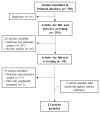Occupational Exposure to Hexavalent Chromium, Nickel and PAHs: A Mixtures Risk Assessment Approach Based on Literature Exposure Data from European Countries
- PMID: 36006111
- PMCID: PMC9414170
- DOI: 10.3390/toxics10080431
Occupational Exposure to Hexavalent Chromium, Nickel and PAHs: A Mixtures Risk Assessment Approach Based on Literature Exposure Data from European Countries
Abstract
Hexavalent chromium (Cr(VI)), nickel (Ni) and polycyclic aromatic hydrocarbons (PAHs) are genotoxic co-occurring lung carcinogens whose occupational health risk is still understudied. This study, conducted within the European Human Biomonitoring Initiative (HBM4EU), aimed at performing a mixtures risk assessment (MRA) based on published human biomonitoring (HBM) data from Cr(VI), Ni and/or PAHs occupational co-exposure in Europe. After data extraction, Risk Quotient (RQ) and Sum of Risk Quotients (SRQ) were calculated for binary and ternary mixtures to characterise the risk. Most selected articles measured urinary levels of Cr and Ni and a SRQ > 1 was obtained for co-exposure levels in welding activities, showing that there is concern regarding co-exposure to these substances. Similarly, co-exposure to mixtures of Cr(VI), Ni and PAHs in waste incineration settings resulted in SRQ > 1. In some studies, a low risk was estimated based on the single substances’ exposure level (RQ < 1), but the mixture was considered of concern (SRQ > 1), highlighting the relevance of considering exposure to the mixture rather than to its single components. Overall, this study points out the need of using a MRA based on HBM data as a more realistic approach to assess and manage the risk at the workplace, in order to protect workers’ health.
Keywords: European Human Biomonitoring Initiative (HBM4EU); co-exposure; human biomonitoring (HBM); mixture risk assessment (MRA); workplace.
Conflict of interest statement
The authors declare no conflict of interest. The funders had no role in the design of the study, in the collection, analyses, or interpretation of data, in the writing of the manuscript, or in the decision to publish the results.
Figures



Similar articles
-
Setting up a collaborative European human biological monitoring study on occupational exposure to hexavalent chromium.Environ Res. 2019 Oct;177:108583. doi: 10.1016/j.envres.2019.108583. Epub 2019 Jul 10. Environ Res. 2019. PMID: 31330491
-
HBM4EU chromates study: the Portuguese integrated and harmonized study on exposure to hexavalent chromium and related early effects.Ann Work Expo Health. 2025 Feb 25;69(2):147-159. doi: 10.1093/annweh/wxae091. Ann Work Expo Health. 2025. PMID: 39657029
-
HBM4EU chromates study - Overall results and recommendations for the biomonitoring of occupational exposure to hexavalent chromium.Environ Res. 2022 Mar;204(Pt A):111984. doi: 10.1016/j.envres.2021.111984. Epub 2021 Sep 4. Environ Res. 2022. PMID: 34492275
-
Mixture risk assessment and human biomonitoring: Lessons learnt from HBM4EU.Int J Hyg Environ Health. 2023 Apr;249:114135. doi: 10.1016/j.ijheh.2023.114135. Epub 2023 Feb 7. Int J Hyg Environ Health. 2023. PMID: 36758443 Review.
-
The HBM4EU chromates study - Outcomes and impacts on EU policies and occupational health practices.Int J Hyg Environ Health. 2023 Mar;248:114099. doi: 10.1016/j.ijheh.2022.114099. Epub 2022 Dec 17. Int J Hyg Environ Health. 2023. PMID: 36528954 Review.
Cited by
-
Editorial for the Special Issue on "Human Biomonitoring in Health Risk Assessment: Current Practices and Recommendations for the Future".Toxics. 2023 Feb 10;11(2):168. doi: 10.3390/toxics11020168. Toxics. 2023. PMID: 36851043 Free PMC article.
References
-
- CDC/NIOSH . Criteria for a Recommended Standard. Occupational Exposure to Hexavalent Chromium. Centres for Desease Control and Prevention; Atlanta, GA, USA: 2013. DHHS (NIOSH) Publication No. 2013–128.
-
- IARC . IARC Monographs on the Evaluation of Carcinogenic Risks to Humans. IARC; Lyon, France: 2018. Chromium (VI) Compounds; pp. 147–167.
Grants and funding
LinkOut - more resources
Full Text Sources

